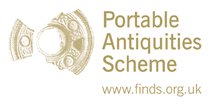Server check!
You are on the training database
Portable Antiquities Annual Report 2015
A full copy of the report can be downloaded as a pdf.
It is with great pleasure that I introduce the Portable Antiquities Scheme Annual Report for 2015, my first as Director of the British Museum.
It is well known that the Portable Antiquities Scheme (PAS) is a great British Museum success story, reaching out across the country to ensure public finds of archaeological interest are recorded for the benefit of all. In 2015 a further 82,272 items were discovered and recorded by the Scheme's 38 locally based Finds Liaison officers, 14 interns generously supported by the Headley Trust, and the 259 volunteers working as part of the HLF funded project, PASt Explorers. The PAS is an amazing partnership, drawing together 119 local museums and other national organisations, to deliver the Scheme's aims. I would therefore particularly like to thank all those involved in making the PAS the success it is. Over the past year, PAS staff, partner organisations and others, have come together to help direct and deliver the scheme looking to its future. The aim is to provide the PAS with a clear direction, based on broad consultation with stakeholders passionate about the Scheme and its work.
Crucial to the PAS are those that have offered finds for recording, of which a large percentage are metal-detectorists. I would particularly like to commend those who have become self-recorders and those who have worked closely with archaeologists when finding discoveries that needed careful excavation in the field. The Code of Practice on Responsible Metal-Detecting provides guidance on what people should do before detecting, whilst detecting and after making their discoveries and I would like to pay tribute to all those that make special efforts to follow this guidance, and therefore ensure metal-detecting has the maximum benefit to archaeology. Recently projects have been established to record archaeological finds made by the public in Denmark (DIME), Flanders (MEDEA), and the Netherlands (PAN), and also a North Sea Area Finds Group
has been formed to ensure pan-European co-operation where public recording systems exit. The aim is to share experiences and expertise, and work closely together on common issues for the advancement of archaeology and public interest in the past. Closer to home the PAS is now integrated within the British Museum's department
of Learning & National Partnerships, to ensure join-up with other projects delivered through the Museum's National Programme in relation to British archaeology. Examples in planning for 2017 will include a touring exhibition on the Vikings, and a summer celebration of Treasure.
Looking ahead, I am keen to see the PAS develop and prosper.
Hartwig Fischer
The PAS in 2015
• 82,272 finds were recorded; a total of 1,211,201 on the PAS database (finds.org.uk/database) to date.
• Almost 90% of finds were found by metal-detectorists.
• 88% of finds were found on cultivated land, where they are susceptible to plough damage and artificial and natural corrosion processes.
• 99% of PAS finds were recorded to the nearest 100m2 (a 6-figure NGR), the minimum requirement for findspot information for Historic Environment Records.
• New sites discovered through finds recorded by the PAS include a Roman villa complex in Wiltshire and a site associated with the English Civil War on the Shropshire/Worcestershire border (page 11).
• Currently 909 people have full access to PAS data for research purposes, and there are a further 8,846 registered users.
• To date, PAS data has been used in 528 research projects, including 25 pieces of large-scale research and 110 PhDs.
• 361,368 unique visitors visited the PAS websites and database, making 680,949 visits and 5,647,064 page requests.
• Publications associated with the work of the PAS include reports in Britannia, British Numismatic Journal, Medieval Archaeology and Post-Medieval Archaeology.
• 521 outreach events took place, including talks, finds days and exhibitions. These were attended by at least 32,568 adults and 1,586 children.
• Finds Liaison Officers had regular contact with 179 metal‑detecting clubs, attending 748 club meetings.


